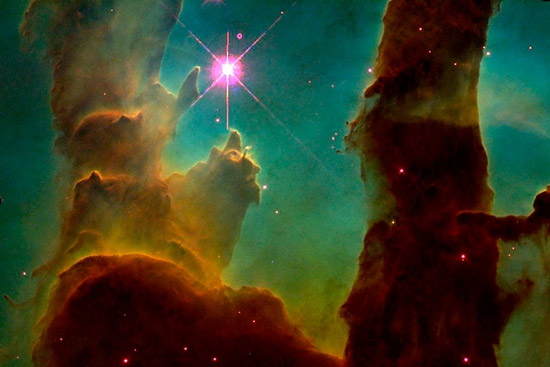Clocking the mosh pit of interstellar space

Hubble image of the Eagle Nebula.
Image: courtesy NASA
The space between the stars in the Milky Way and all other galaxies is full of dust and gas, the raw materials from which stars and planets are made.
But the dynamics of these galactic mosh pits, which are perhaps best known through the spectacular images from the Hubble Space Telescope of towering nebulas caught in the act of churning out stars, are still mysterious. Now, an international team of scientists, including two from the University of Wisconsin–Madison, has clocked the turbulence of the warm ionized gas in interstellar space, a measurement that promises a better handle on a process responsible for regulating the appearance and composition of the Milky Way.
The work is reported today (Oct. 5) in the journal Nature.
“All the stars with their planetary systems are born out of the interstellar medium,” explains UW–Madison astronomy professor Alexander Lazarian who, with graduate student Blakesley Burkhart, contributed the theoretical foundation of the new study. “The interstellar medium is a multiphase system with complex interactions between molecular clouds, diffuse gas of different temperatures and densities, as well as magnetic fields penetrating and critically affecting all the phases.”
Understanding the dynamics of the interstellar medium is important, Lazarian asserts, because it is responsible for the one essential process of all galaxies: star formation. But turbulence in the interstellar medium has only attracted the interest of astrophysicists in the last decade thanks to advances in both theory and observation. New measurements using a variety of techniques, in addition to images from telescopes such as Hubble, have helped create a new portrait of the interstellar medium, revealing highly irregular dust and gas features moving at supersonic speeds.
But describing the complex swirl of the interstellar medium and inferring its properties is extremely difficult. Complicating the picture is the presence of powerful interstellar magnetic fields that influence the ebb and flow of interstellar dust and gas. The Nature study, says Burkhart, provides a new measure of that magnetic turbulence.
Collaborating with Bryan Gaensler, a professor of astronomy at the University of Sydney, as well as other Australian and Dutch groups, Burkhart and Lazarian used their newly developed statistical methods to make “synthetic observations” to match the results of the Southern Galactic Plane radio survey of the Milky Way obtained from a radio telescope known as the Australian Telescope Compact Array.
“It’s a bit of a matching game between numerics and observations using statistics,” notes Burkhart. “In the case of these observations, the data cover a large swath of the galaxy, in particular tracing warm ionized gas, which is one phase of the interstellar medium.”
The statistical techniques devised by Burkhart and Lazarian help build a refined picture using all available data on the turbulent properties of the swirling clouds that thread between the stars. “It is advantageous to use all the available information,” according to Lazarian. “If we can use different types of information and get the same answer on the properties of the turbulent media, this is very encouraging.”
Blending the radio observations with the simulated observations showed that the warm ionized gas in the interstellar medium is moving at about the speed of sound. “One implication of this,” Burkhart says, “is we see a large difference in environment between this diffuse warm ionized gas and the cold molecular gas, which forms stars and generally moves faster than sound.”
“While the result may seem esoteric, it will help rewrite astrophysics textbooks,” says Lazarian, “because the work reveals the key role of turbulence in the various phases of the interstellar medium. This is a very different picture from that still in most textbooks on astrophysics where the interstellar medium in galaxies can be treated mostly like a static one.”




